Whether you like earthy or floral notes, we are covering all different types of green tea in this helpful guide to 16 types of green tea!
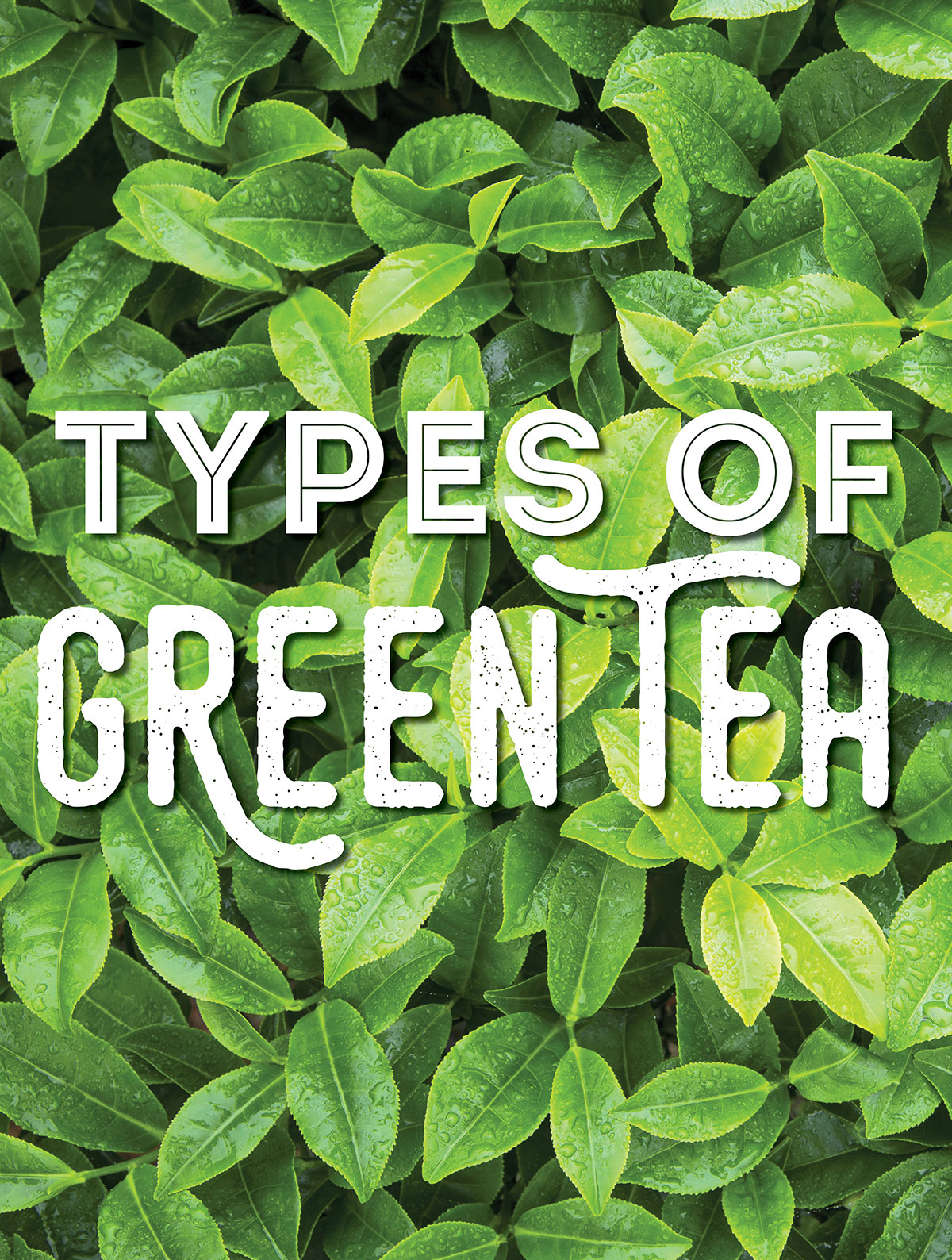
Green tea is more than just matcha, and if you want to learn more about the other varieties then it’s your lucky day! We will give a brief description of each of these green teas and then dive further into the specifics of each, so you can learn as much or as little about each as you wish.
Green tea kombucha is one of our favorite ways of using this tea variety. Most of these types of green tea will work well for kombucha brewing!
Trivia Time! We have all heard the expression “Not for All the Tea in China” which pretty much means not at any price. But, where and when did this expression come from? Scroll to the bottom of the article for the answer.
1. England in the Mid 18th Century
2. Australia in the Late 19th Century
3. China in the 12th Century
4. Japan in the Early 20th Century
Health Benefits of Green Tea
Green teas offer several potential health benefits, thanks to their rich antioxidant content and other bioactive compounds. Green teas contain varying amounts of catechins, which are powerful antioxidants known for their potential to fight free radicals and reduce oxidative stress.
While we can’t speak to the accuracy of these claims, green tea is also claimed to reduce the risk of cardiovascular disease, improve the immune system, and promote overall health. We can state that it has a pleasant taste and aroma
We are sometimes asked “Is Green Tea Keto?” Sure as long as you don’t add much, or any, sugar or other sweeteners.
Types of Green Tea
- Bancha
- Genmaicha
- Gunpowder
- Gyokuro
- Hojicha
- Jasmine
- Kabusecha
- Kamairicha
- Konacha
- Kukicha
- Longjing
- Matcha
- Moroccan Mint Tea
- Sencha
- Steamed Green Tea (Fukamushi)
- Tencha
Bancha

Bancha is a type of green tea, specifically a sencha tea. Sencha refers to the method of processing the tea leaves, which involves steaming and rolling the leaves to preserve their natural flavor and color.
Origin and Production: Bancha tea is a type of Japanese green tea often considered an everyday tea in Japan, and is enjoyed by many for its mild taste and low caffeine. Bancha tea is made from the larger and older leaves of the tea plant, usually harvested in the late summer or autumn season. The leaves used for bancha are picked after the first flush of young, tender leaves used in higher-grade teas like gyokuro or sencha.
Flavor: Bancha tea has a distinctive flavor characterized by its mild and grassy taste. Compared to other green teas, it has a slightly more robust and earthy flavor due to the older leaves used in its production. The flavor is often described as refreshing and slightly nutty.
Caffeine Content: Bancha tea is known for its relatively low caffeine content compared to other green teas. This makes it a popular choice for those who are sensitive to caffeine or prefer a milder tea option. The lower caffeine content also means it can be enjoyed throughout the day without the same potential for caffeine jitters or lost sleep.
Brewing: Bancha tea is typically prepared by steeping the tea leaves in hot water, usually around 176-194°F (80-90°C), for about 1-2 minutes. The steeping time and water temperature, however, can be adjusted according to personal preference. Some people even enjoy brewing bancha tea with cooler water for a milder flavor.
Bancha tea is a versatile and enjoyable beverage that can be enjoyed hot or cold. Its mild flavor and health benefits make it a popular choice among tea enthusiasts who appreciate the unique characteristics of Japanese green teas.
Genmaicha
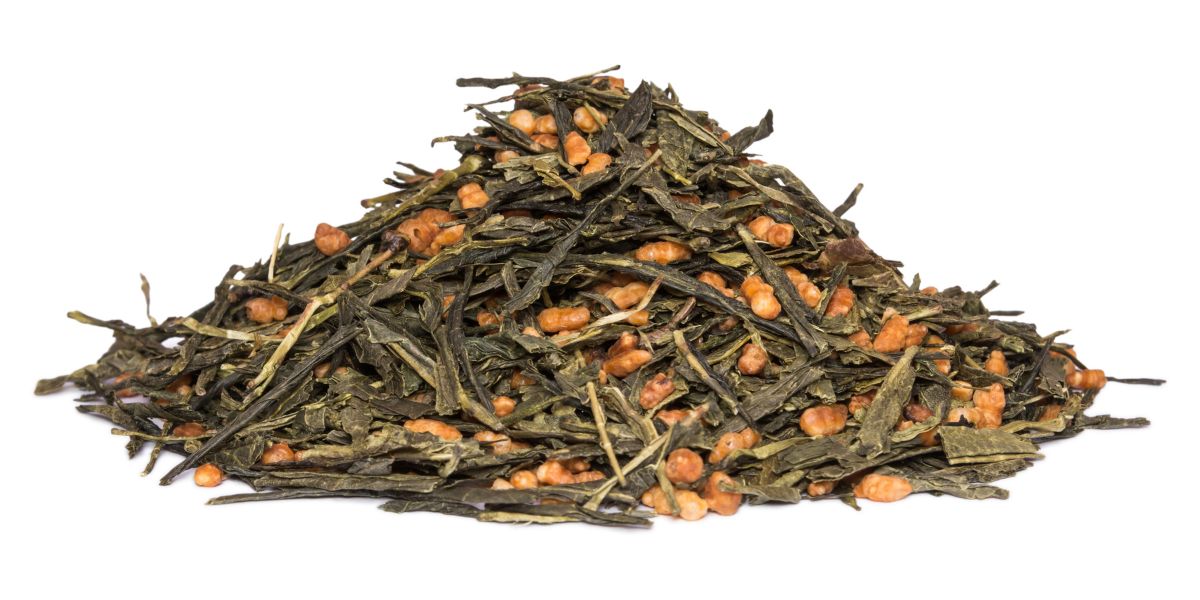
Genmaicha green tea is a traditional Japanese green tea that is also known as “popcorn tea” or “brown rice tea.” It is made by combining roasted brown rice grains (genmai) with green tea leaves (usually sencha or bancha). This unique blend creates a distinctive flavor and appearance.
Origin and Production: Genmaicha tea dates back to the 15th or 16th century in Japan when tea was a luxury not a commodity. During that time, the common people added roasted rice to their tea to make it more affordable and to extend the quantity. Over time, genmaicha became popular and developed into a distinct tea variety. The production process of genmaicha involves roasting the brown rice grains until they turn golden brown. Then, the roasted rice is mixed with the green tea leaves. The rice imparts a nutty, toasty flavor to the tea, while the green tea provides a fresh, grassy note.
Flavor and Appearance: Genmaicha tea has a light golden color and a mild, earthy aroma. The flavor is often described as a combination of roasted rice and grassy green tea, with a slightly sweet and savory undertone. One of the unique characteristics of genmaicha is the presence of popped rice kernels in the tea. During the roasting process, some of the rice grains expand and pop, resembling popcorn. These popped kernels add a pleasant crunch to the tea and enhance its overall texture.
Caffeine Content: Genmaicha is generally a low-caffeine tea, making it suitable for those who prefer a milder option or are sensitive to caffeine.
Cultural Significance: In Japan, genmaicha is commonly enjoyed with meals or as a casual everyday tea. Its balanced flavor makes it a versatile choice that pairs well with a variety of foods, including sushi, grilled meats, and light snacks. It is also a popular choice for tea ceremonies, where its rustic character adds a unique touch to the experience.
Gunpowder
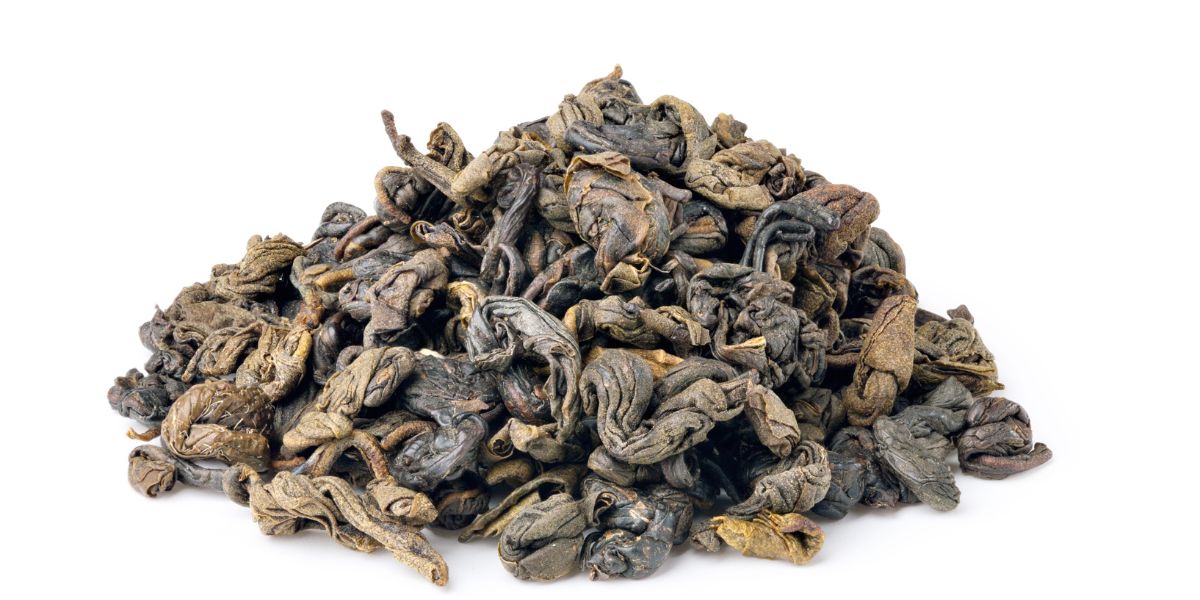
Gunpowder green tea is a type of that is known for its unique appearance and flavor. The name “gunpowder tea” comes from the tea leaves resemblance to gunpowder pellets used in early firearms.
Origin and Production: Gunpowder tea originated in China and is still widely produced and enjoyed there, as well as in other tea-producing regions around the world. The tea leaves used for gunpowder tea are typically harvested early in the season when they are young and tender. After harvesting, the leaves undergo a steaming and rolling process. The rolling is usually done by hand or using machines that mimic the by hand process. The rolling tightens the leaves into small pellets, which helps to retain the tea’s flavor and aroma.
Flavor, Aroma, and Appearance: Gunpowder tea has a unique flavor profile. It is often described as robust, smoky, and slightly bitter with a hint of sweetness. The smoky taste is a result of the firing process during production. The tea also has a distinct aroma that can be described as earthy and grassy. Gunpowder tea is characterized by its tightly rolled tea leaves, which have a distinctive appearance, which as we said, resembles small pellets or grains of gunpowder. This rolling process helps to preserve the tea’s freshness and flavor.
Caffeine Content: Gunpowder tea is a green tea, which means it contains caffeine. The caffeine content, however, varies depending on factors such as brewing time and temperature. On average, gunpowder tea contains less caffeine than black tea but more caffeine than other types of green tea.
Brewing Method: To prepare gunpowder tea, it is common to use water that isn’t boiling hot, usually around 176°F to 185°F (80°C to 85°C). Steep the tea leaves for about 2 to 3 minutes, or adjust the steeping time to your preference. The tightly rolled leaves gradually unfurl during brewing, releasing their flavor into the water.
Gunpowder tea is popularly consumed on its own or as a base for traditional Moroccan mint tea. It can be enjoyed both hot and iced, and some people also use it as an ingredient in cooking and baking.
Gyokuro
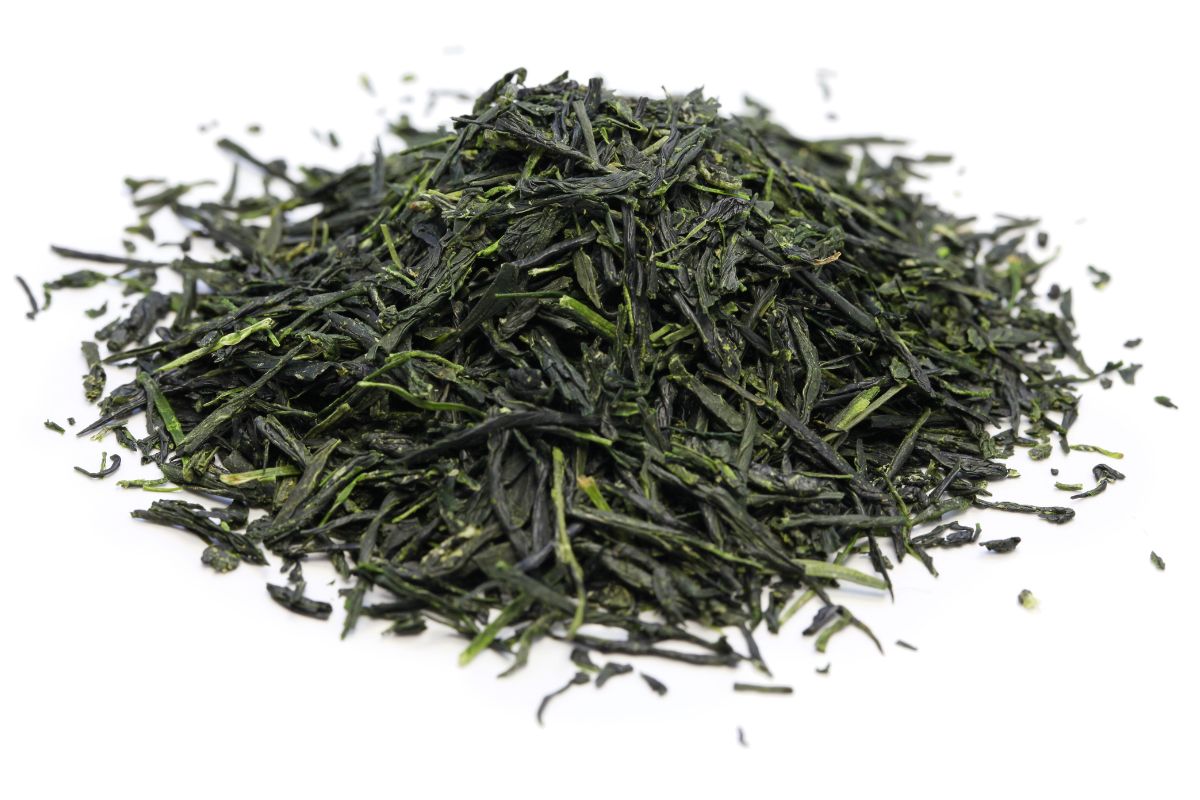
Gyokuro green tea is a high-quality Japanese green tea known for its rich flavor, vibrant green color, and distinct aroma. It is considered one of the finest and most expensive types of green tea available. The name “gyokuro” translates to “jade dew” or “jewel dew.”
Origin and Production: Gyokuro tea is produced from the same Camellia sinensis plant as other green teas, but its unique cultivation and processing methods set it apart. It is grown in shaded conditions for several weeks before harvesting, which enhances its flavor and aroma. Shading slows down the growth of the tea leaves, resulting in increased chlorophyll content, reduced bitterness, and the development of a unique umami taste.
Flavor, Aroma, and Appearance: Gyokuro tea has a pale green hue, a sweet and grassy aroma, and a rich, full-bodied taste. It is often described as having notes of seaweed, spinach, and steamed vegetables, with a lingering sweetness and a slight astringency. The tea is typically enjoyed without any additives to fully appreciate its unique flavors.
Brewing: To brew gyokuro tea, a lower water temperature and longer steeping time are recommended compared to other green teas. The water temperature should be around 60-70°C (140-158°F), and the leaves are steeped for about 2-3 minutes. This gentle brewing method allows the tea’s flavors to fully infuse into the water, resulting in a smooth, complex, and aromatic cup of tea.
Cultural Significance: Gyokuro tea is cherished in Japanese tea ceremonies and is considered a luxury tea in Japan. It is also popular among tea connoisseurs worldwide who appreciate its exceptional quality and distinctive taste. The high cost of gyokuro is mainly due to its labor-intensive cultivation, limited availability, and meticulous processing methods.
Hojicha
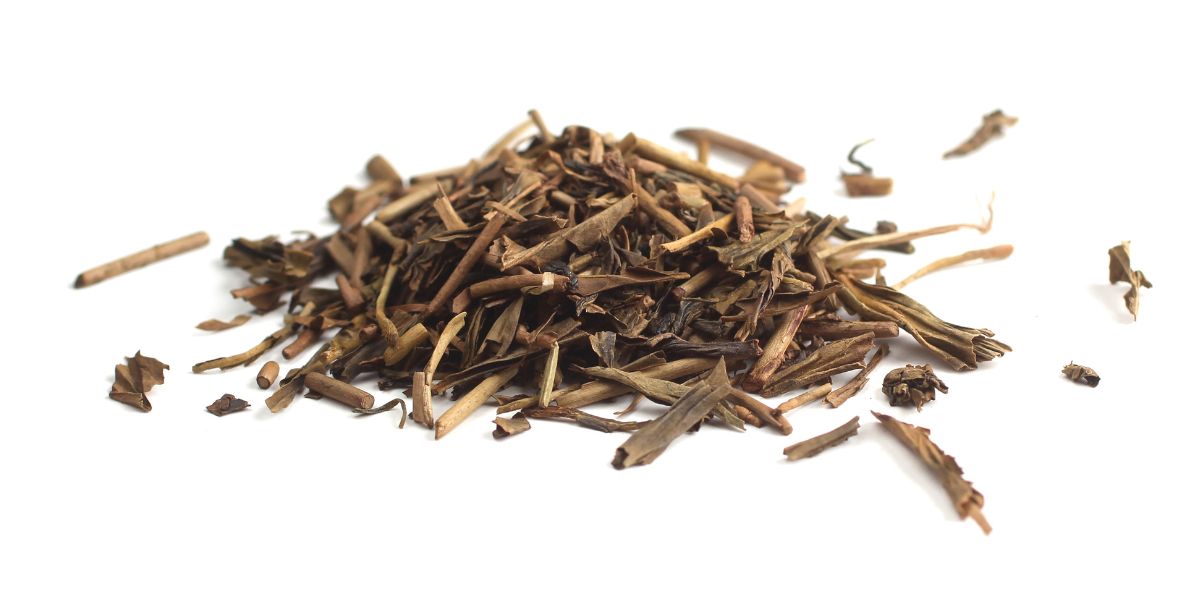
Origin and Production: Hojicha green tea is a traditional Japanese green tea that is distinct from other types of green tea due to its unique roasting process. It is made from the leaves of the Camellia sinensis plant, the same plant used to produce other green teas like sencha and matcha. Hojicha undergoes a roasting process that gives it a distinctive flavor, aroma, and appearance. This process involves heating the tea leaves at a high temperature, typically in a porcelain or cast iron pot over charcoal. The leaves are roasted until they turn a reddish-brown color, giving hojicha its characteristic appearance
Flavor, Appearance, and Aroma:. The production method just described gives hojicha tea a warm, toasty flavor profile with a rich aroma. It is often described as having a nutty, caramel-like taste with hints of roasted grains. The roasting process gives hojicha a smooth and mellow flavor, which makes it a popular choice for those who prefer a less grassy or astringent taste compared to other green teas.
Caffeine Content: Hojicha is typically low in caffeine compared to other green teas, making it a suitable choice for those who are sensitive to caffeine or prefer a beverage with less stimulant content.
Brewing: It can be brewed using boiled water or down to a temperature around 90°C (194°F) for 30 seconds to 1 minute, depending on personal preference. The tea leaves can be steeped multiple times, and subsequent infusions may have slightly different flavor profiles. In Japan, hojicha is often enjoyed both hot and cold.
Hojicha tea is versatile and can be incorporated into various culinary creations. It can be used as an ingredient in desserts, such as ice cream or baked goods, to add a unique flavor. Hojicha latte, a combination of hojicha tea and milk, has also gained popularity as a comforting and flavorful beverage.
Jasmine

Jasmine green tea is flavored with the aroma of jasmine flowers. The tea leaves are harvested and processed in a way that allows them to absorb the fragrance of fresh jasmine blossoms.
Origin and Production: Jasmine originated in China, but is today one of the most popular scented teas in the world.The production of jasmine tea involves combining tea leaves with jasmine flowers. The flowers are usually picked in the morning when they are still closed, and then stored in a cool place. In the evening, when the flowers open and release their fragrance, they are mixed with the tea leaves. The tea leaves absorb the floral scent overnight. This process can be repeated multiple times to enhance the flavor.
Flavor and Aroma: Jasmine tea has a delicate and refreshing flavor with a floral aroma. The taste can vary depending on the type of tea used as the base. Green tea-based jasmine tea tends to have a slightly grassy and slightly sweet taste, while white tea-based jasmine tea is milder and more delicate.
Brewing: To brew jasmine tea, you can use either loose tea leaves or tea bags. It’s recommended to use water that is around 175-185°F (80-85°C) for green tea-based jasmine tea and steep it for 2-3 minutes. Adjust the brewing time and temperature according to your preference. You can also experiment with multiple infusions using the same leaves to extract different flavors.
Serving: Jasmine tea is often enjoyed on its own, without any additional sweeteners or additives, to fully appreciate its natural flavor and aroma. However, some people prefer to add a touch of honey or sugar to enhance the sweetness. It can be served hot or iced, depending on personal preference.
Varieties: Jasmine tea is typically made using green tea as the base, but it can also be made with other types of tea, such as white tea or black tea. Green tea is the most common choice due to its delicate flavor that compliments the floral notes of jasmine.
Jasmine tea is not only a delightful beverage but also a symbol of elegance and tranquility in many tea-drinking cultures. Its fragrant aroma and soothing taste make it a popular choice for tea enthusiasts around the world.
Kabusecha

Kabusecha green tea is a type of tea that holds a special place in Japanese tea culture. It is known for its delicate flavor, vibrant green color, and unique production process. Kabusecha falls between sencha (standard green tea) and gyokuro (shade-grown green tea) in terms of flavor.
Origin and Production: The word “kabuse” in Japanese means “to cover” or “to shade,” which refers to the cultivation method used for Kabusecha. The tea plants are grown in the shade for a certain period before harvesting. This shading process typically lasts around 1-2 weeks. By reducing the amount of sunlight reaching the leaves, the tea plants undergo certain changes to their composition and flavor.
The shading stimulates the tea leaves to produce higher levels of chlorophyll and amino acids, particularly L-theanine. This results in a sweeter, smoother taste and a deeper, richer aroma compared to sencha. The increased amino acid content also contributes to the tea’s umami flavor, which is one of its defining characteristics.
The leaves used for Kabusecha are harvested once the shading period is complete. After harvesting, the leaves are steamed to stop oxidation and preserve their vibrant green color. They are then rolled and dried to create the final product.
Flavor, Aroma, and Appearance: When brewed, Kabusecha tea yields a bright green infusion with a fresh, grassy aroma. Its flavor is often described as a harmonious balance of sweetness, umami, and a slight astringency. The tea is typically enjoyed without any additives to fully appreciate its nuanced taste.
Cultural Significance: Kabusecha is considered a premium tea in Japan and is often savored during special occasions or as a treat. It offers a more refined experience compared to sencha, yet it is usually more accessible in terms of price compared to the highly prized gyokuro.
Kabusecha represents a delightful middle ground between sencha and gyokuro, providing tea enthusiasts with a unique and enjoyable drinking experience.
Kamairicha
Kamairicha green tea is a type of Japanese tea that is characterized by its unique production method and flavor profile. It is often considered one of the less well-known varieties of Japanese green tea compared to more popular types like sencha or matcha.
Origin and Production: Kamairicha is produced by pan-frying the tea leaves in a hot iron pan or wok, which is different from the steaming process used for most Japanese green teas. This pan-firing method gives Kamairicha a distinct flavor and aroma.
Flavor, Aroma, and Appearance: Kamairicha has a refreshing and savory flavor with a delicate sweetness. It is often described as having a milder taste compared to other Japanese green teas. The pan-firing process imparts a unique smoky or roasted note to the tea, which adds to its overall flavor complexity. The leaves of Kamairicha are usually twisted and curly, similar to Chinese green teas. The color of the leaves can range from deep green to yellowish-green.
The aroma of Kamairicha is generally fresh and vegetal, with hints of grass and seaweed. Some variations may have a slightly nutty or toasty aroma due to the pan-firing process.
Caffeine Content: Like other green teas, Kamairicha contains caffeine, but the exact amount can vary depending on factors such as the tea leaves’ quality and brewing method. Generally, green teas have lower caffeine content compared to black tea or coffee.
Brewing Method: To brew Kamairicha, we recommend using water that is around 70-80°C (160-175°F) to preserve its delicate flavors. Steep the leaves for about 1-2 minutes, although the exact brewing time can be adjusted based on personal preference. It’s advisable to experiment with different steeping times to find the flavor strength that suits you best.
Kamairicha green tea offers a unique and enjoyable tea-drinking experience, and it can be a great choice for those looking for a slightly different flavor profile compared to other Japanese green teas.
Konacha
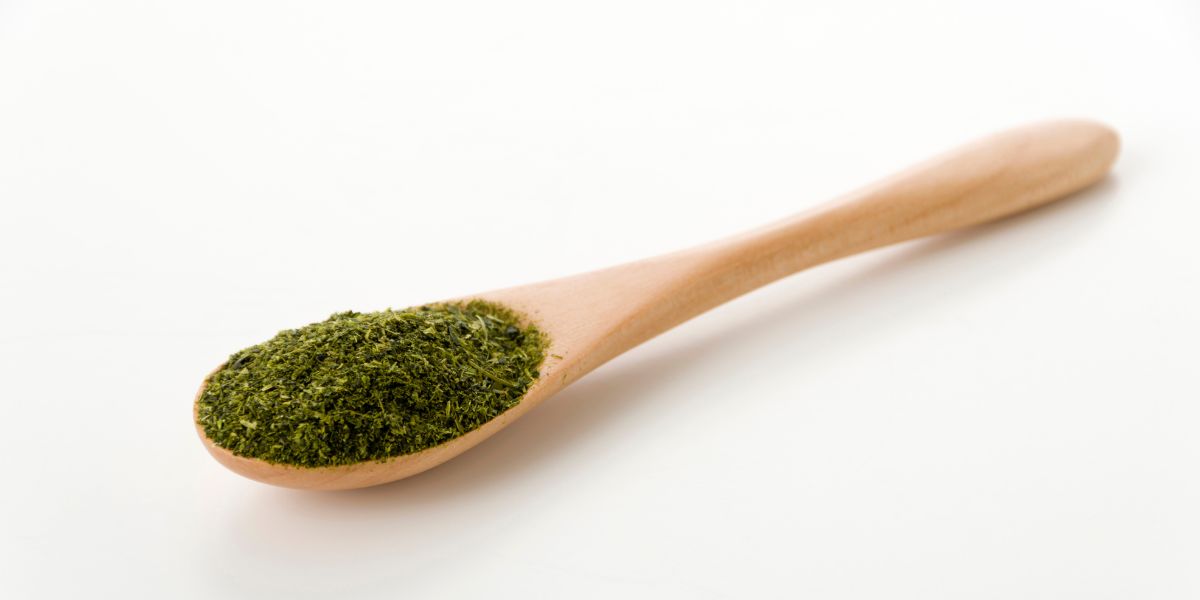
Konacha is a type of Japanese green tea that has a distinct appearance and flavor. It is often referred to as “powdered tea” or “dust tea” due to its fine, powdery consistency.
Origin and Production: Konacha green tea is made from the same tea leaves as high-quality sencha, but it is composed of the smaller broken tea leaves, buds, and tea dust that result from the sorting process.
Flavor, Aroma, and Appearance: Konacha has a strong and robust flavor compared to other Japanese green teas. It is often described as being slightly bitter, grassy, and vegetal, with a refreshing and earthy taste. Konacha has a vibrant green color and a powdery texture. It consists of tiny tea particles, which create a cloudy appearance when brewed.
Caffeine Content: The caffeine content in Konacha varies depending on factors such as the brewing time and temperature. Generally, Japanese green teas have a moderate caffeine content compared to black tea or coffee.
Brewing Method: Due to its small particle size, Konacha is typically brewed in a unique way. It is commonly prepared using a fine-meshed tea strainer or by pouring hot water directly into a teapot with the tea leaves. The tea is then served in small cups, and the fine particles may settle at the bottom of the cup.
Cultural Significance: Konacha is often enjoyed in Japanese tea ceremonies and is also commonly served in casual settings like sushi restaurants. Its robust flavor pairs well with a variety of Japanese cuisine, making it a popular choice to accompany meals.
Konacha green tea offers a unique and flavorful experience, providing a robust taste and the potential health benefits associated with green tea consumption.
Kukicha
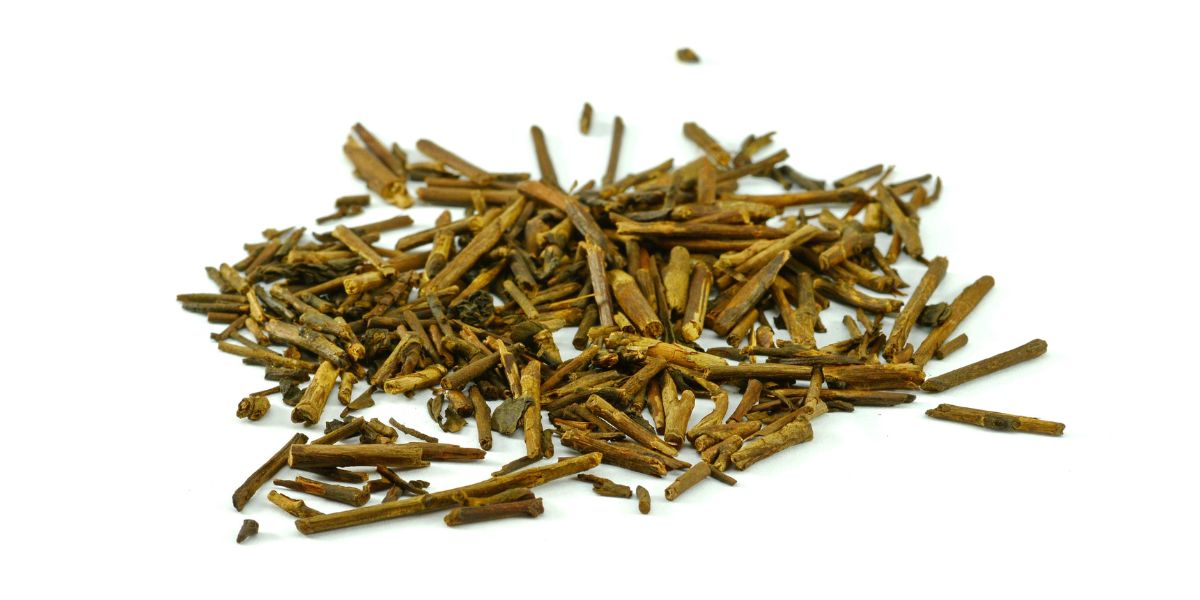
Kukicha green tea, also known as “twig tea” or “bōcha,” is a type of Japanese green tea that is made primarily from the stems, stalks, and twigs of the tea plant (Camellia sinensis).
Origin and Production: Unlike most green teas, which are made from the leaves, kukicha is made from the parts of the plant that are typically discarded during the production of other teas.
The production of kukicha tea involves gathering the stems and twigs from the tea plant after the leaves have been harvested. These stems and twigs are then dried and aged, which imparts a unique flavor to the tea. The resulting brew has a mild and slightly sweet taste, with a delicate aroma.
Caffeine Content: One of the distinguishing characteristics of kukicha is its low caffeine content. Since the stems and twigs contain less caffeine than the leaves, kukicha is often recommended for those who are sensitive to caffeine or prefer a milder tea. It can be enjoyed throughout the day without causing the jitters or interfering with sleep.
Brewing Method: Kukicha is usually brewed with water that is around 176-185°F (80-85°C) and steeped for a shorter time compared to other green teas, typically around 1-2 minutes. The resulting liquor has a light green color and a pleasant, mild flavor.
Kukicha is commonly available in loose-leaf form or in tea bags. It can be enjoyed on its own or blended with other ingredients like roasted rice (creating a tea called “genmaicha”) or matcha (creating a tea called “karigane matcha”).
Overall, kukicha green tea offers a unique and refreshing alternative to traditional green teas. Its distinctive flavor, low caffeine content, and potential health benefits make it a popular choice among tea enthusiasts.
Longjing

Longjing green tea, also known as Dragon Well tea is one of the most famous and highly regarded teas in China, renowned for its delicate flavor, beautiful appearance, and rich cultural history.
Origin and Production: Longjing tea originates from the West Lake area near Hangzhou in Zhejiang province, China. Longjing tea is made from the leaves of a specific tea cultivar called Camellia sinensis var. sinensis. The tea leaves are typically harvested in early spring before the Qingming Festival (Tomb-Sweeping Day). The timing of the harvest is crucial as it affects the flavor and quality of the tea.
Flavor and Appearance: The flavor of Longjing tea is known for its subtlety and complexity. It has a refreshing, mellow taste with a hint of chestnut and a sweet, lingering aftertaste. The tea is often described as having a “nutty” or “grassy” flavor. The quality of the tea can vary depending on factors such as the growing conditions and the skill of the tea master. Longjing tea leaves are flat and smooth with a distinct emerald-green color. The leaves are often described as resembling the shape of a sparrow’s tongue or a dragon’s well (as in a water well), hence the name “Dragon Well Tea”.
Brewing: Longjing tea is typically brewed using a specific method known as the Gongfu tea ceremony. The tea leaves are steeped in a small teapot or a glass, using water at a temperature around 80°C (176°F). The leaves can be infused multiple times, and each infusion reveals different flavors and aromas.
Cultural Significance: Longjing tea has a long and storied history that dates back over a thousand years. It is deeply ingrained in Chinese culture and has been praised in poetry, literature, and art. The tea has also been a favorite of emperors, scholars, and tea enthusiasts throughout history.
Grades and Varieties: Longjing tea is available in different grades, which are often distinguished by the quality of the leaves and the picking standards. The highest grade is known as “Lion Peak” or “Shi Feng,” which is grown on the Lion Peak Mountain and is highly prized. Other popular varieties include “Meijiawu,” “Wengjiashan,” and “Yuezhou Longjing.”
Longjing tea is not only cherished in China but has gained popularity worldwide due to its unique taste and cultural significance. Whether you enjoy its delicate flavor or appreciate its historical significance, Longjing tea offers a truly exceptional tea-drinking experience.
Matcha

Matcha green tea is a type of powdered tea that originated in Japan. It has gained popularity worldwide for its unique flavor, vibrant green color, and potential health benefits.
Origin and Production: Matcha tea comes from the Camellia sinensis plant, the same plant used to produce other types of tea. However, what sets matcha apart is the cultivation and processing method. The tea bushes are shaded for several weeks before harvest which enhances the chlorophyll content and gives the leaves a rich green color. The leaves are typically hand-picked, selecting the youngest and tenderest leaves. After picking, the stems and veins are removed, and the leaves are ground into a fine powder using traditional stone mills.
Flavor and Aroma: Matcha has a distinct flavor profile that can be described as grassy and slightly sweet. Some variations may have hints of umami, a savory taste. The aroma is fresh and earthy.
Caffeine Content: Matcha contains caffeine, but the overall caffeine level can vary depending on factors like the quality of the tea leaves and the amount used. On average, matcha contains about 35 milligrams of caffeine per teaspoon (approximately 2 grams). However, compared to coffee, the effects of matcha’s caffeine are often described as more balanced and gentle due to the presence of other compounds such as L-theanine. We would suggest that the main difference is that a Starbucks coffee can easily exceed 200 mg of caffeine.
Brewing Method: Traditional preparation involves sifting matcha powder into a bowl, adding hot water (not boiling), and whisking it vigorously with a bamboo whisk called a chasen until it becomes frothy. The resulting tea is then sipped directly from the bowl. Matcha is not limited to tea preparation alone. It is also used as an ingredient in various culinary creations, such as matcha-flavored desserts, ice creams, smoothies, and baked goods.
Cultural Significance: Matcha has a long-standing association with Japanese tea ceremonies, where it is prepared and served with great care and attention. The tea ceremony is a ritualistic practice that embodies principles of harmony, respect, purity, and tranquility.
Grades and Quality: When purchasing matcha, it’s important to look for high-quality ceremonial-grade or culinary-grade matcha from reputable sources, as the quality can greatly affect the taste and overall experience.
Moroccan Mint Tea
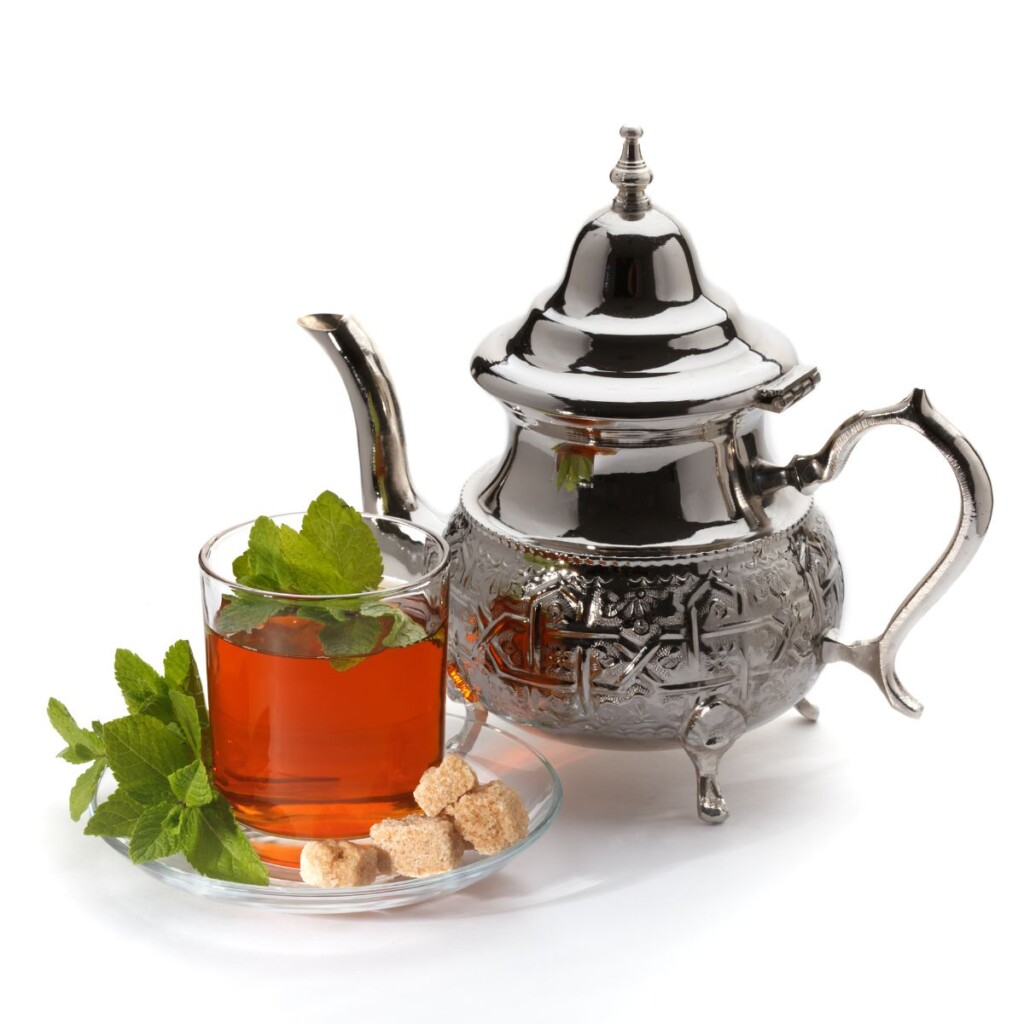
Moroccan Mint Green tea is also known as “Maghrebi Mint tea” or “Moroccan tea,” and is a traditional hot beverage that holds a special place in Moroccan culture.
Production: This tea is traditionally made of three components: Gunpowder green tea, spearmint or peppermint leaves, and sugar. Fresh mint leaves are considered essential for achieving the authentic flavor of Moroccan Mint tea, and sugar is seen as necessary to balance the bitterness of the tea and enhance the overall taste. The amount of sugar can vary based on personal preference, but it is typically served on the sweeter side.
Flavor and Cultural Significance: It is a refreshing and aromatic tea that is commonly served throughout Morocco and is a symbol of hospitality and friendship. It is traditionally served in small, decorative glasses with intricate designs. The tea is poured from a height to create a frothy layer on top. This technique also helps to cool the tea slightly before it is consumed. It is customary for the host to pour the tea in a continuous stream into each glass, demonstrating generosity and hospitality.
Moroccan Mint tea is often served alongside Moroccan pastries, such as msemen (a type of pancake) or kaab el ghazal (gazelle horns). It is enjoyed throughout the day in Morocco, including breakfast, after meals, and during social gatherings.
The act of serving Moroccan Mint tea is considered a ritual, and it holds great cultural significance. It is a symbol of hospitality and is often used to welcome guests into homes or as a gesture of friendship. The tea is typically served in multiple rounds, with each round having a slightly different flavor as the mint infuses further.
Moroccan Mint tea is not just a beverage; it is an integral part of Moroccan culture and a representation of their warm hospitality and traditions.
Sencha

Sencha green tea is a type of Japanese tea that holds significant cultural and historical importance. It is one of the most popular and widely consumed teas in Japan, and is known for its vibrant green color, refreshing taste, and numerous health benefits.
Origins and Production: Sencha tea originated in Japan and is made from the leaves of the Camellia sinensis plant. The tea leaves are grown in full sunlight, which differentiates it from shaded teas like Gyokuro and Matcha. Sencha is typically harvested in the first or second flush, yielding high-quality leaves.
Flavor and Appearance: Sencha tea has a delicate, refreshing flavor with a slight astringency. It often exhibits a grassy or vegetal taste, reminiscent of seaweed or fresh-cut grass. The aroma is usually sweet and mildly nutty. When brewed, Sencha tea has a vibrant green color and a clear, pale yellow liquor.
Caffeine Content: Sencha tea contains a moderate amount of caffeine, although it is generally lower than that found in black tea or coffee. The caffeine content varies depending on factors like the tea leaves quality, processing, and brewing method.
Brewing Method: To brew Sencha tea heat water to around 75-80°C (167-176°F), but avoid using boiling water as it can scorch the leaves and result in a bitter taste. Measure approximately 1 teaspoon (2 grams) of Sencha tea leaves per 8-ounce cup. Place the tea leaves in a teapot or tea infuser. Pour the heated water over the tea leaves and let it steep for about 1-2 minutes. Strain the tea and serve either hot or cold.
Grades and Quality: Sencha tea comes in various grades, reflecting the quality of the tea leaves. Higher grades tend to have younger leaves and a more delicate flavor. The highest-quality Sencha teas are usually produced in limited quantities and can be relatively expensive.
Cultural Significance: Sencha tea holds a special place in Japanese tea culture. It is commonly consumed in everyday life and is often served to guests as a gesture of hospitality. Tea ceremonies, such as the casual Chado or Way of Tea, often include Sencha as one of the tea options.
Steamed Green Tea (Fukamushi)
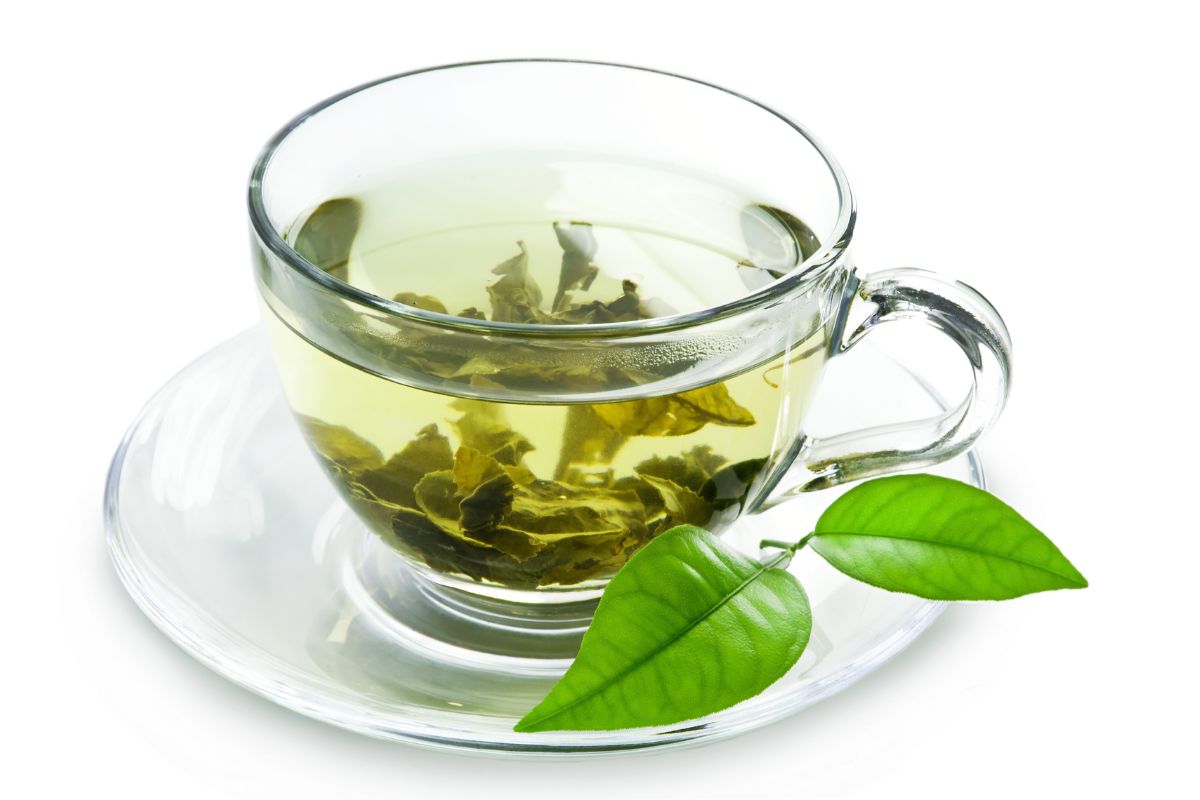
Steamed green tea, specifically Fukamushi green tea, is a type of Japanese tea that has gained popularity for its unique characteristics and brewing method. Fukamushi translates to “deep-steamed” in Japanese, referring to the longer steaming process compared to other green teas.
Origin and Production: Fukamushi green tea is primarily produced in Japan, with regions such as Shizuoka, Kagoshima, and Kyoto being known for their high-quality teas. The tea leaves used for Fukamushi are usually harvested in early spring, known as the first flush, which yields the most delicate and flavorful leaves. What sets Fukamushi green tea apart is its extended steaming time. The tea leaves are steamed for approximately 2-3 minutes, which is significantly longer than the steaming time for other green teas. This extra steaming time breaks down the leaf structure, resulting in finer and smaller tea leaves.
Flavor, Aroma, and Appearance: Due to the longer steaming process, Fukamushi green tea leaves appear more fragmented and broken compared to other green teas. They may also have a deeper green color and a powdery texture. Fukamushi green tea is known for its rich and intense flavor profile. The extended steaming process releases more flavor compounds from the tea leaves, resulting in a deeper and slightly more astringent taste. It often has a vibrant, vegetal flavor with hints of umami. The aroma of Fukamushi green tea is also robust and refreshing.
Brewing Method: To brew Fukamushi green tea, it is recommended to use slightly cooler water compared to other green teas, around 70-80°C (158-176°F). The lower temperature helps to prevent the tea from becoming overly bitter. The steeping time is usually shorter, around 30-60 seconds, as the smaller leaf particles release flavor more quickly.
Fukamushi green tea offers a unique and robust tea-drinking experience. Its deep-steamed processing method contributes to its distinctive flavor and appearance, making it a popular choice among tea enthusiasts who appreciate a bolder and more intense cup of green tea.
Tencha
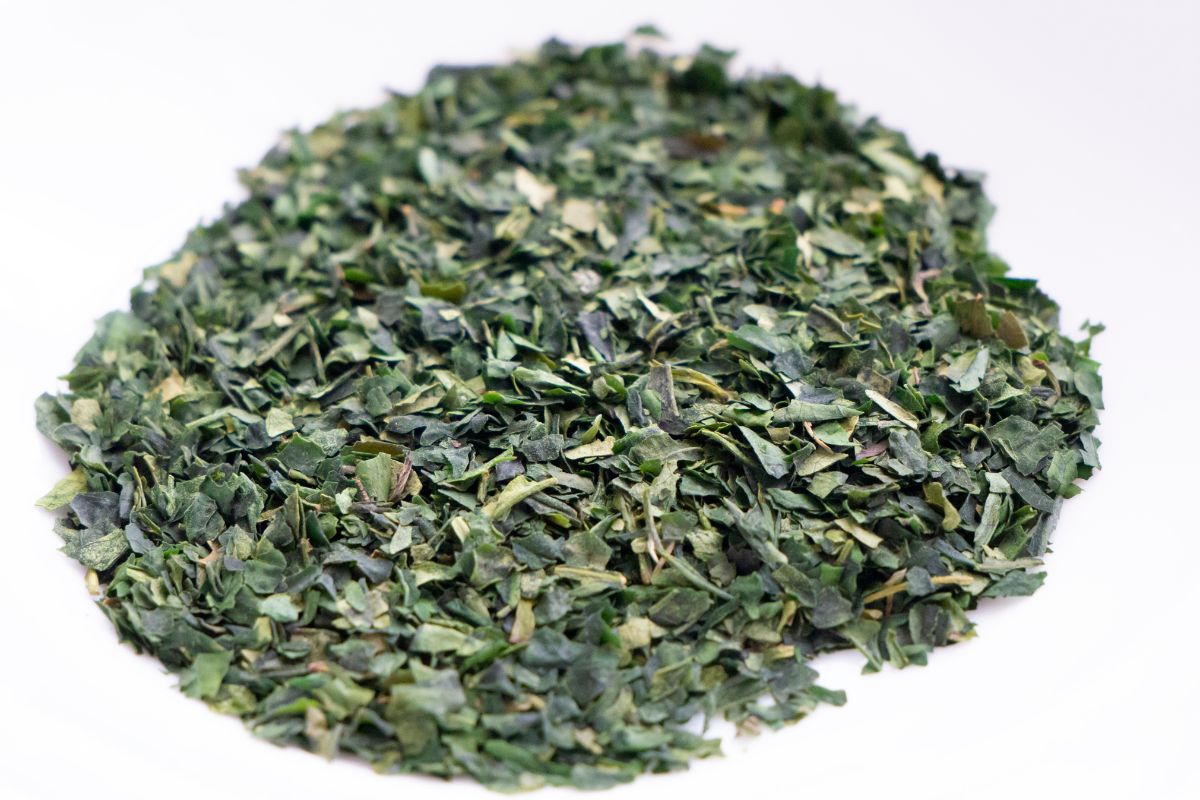
Tencha green tea is a type of Japanese green tea that is known for its vibrant green color and unique cultivation process. It is the precursor to matcha, another popular Japanese green tea.
Origin and Production: Tencha is primarily grown in shaded tea gardens in Japan. The tea plants are covered with shade cloths for several weeks before harvest to promote the growth of tender leaves with high chlorophyll content.
The leaves used for tencha are carefully hand-picked, selecting only the finest and youngest leaves from the tea bushes. The stems and veins are removed, leaving only the fleshy part of the leaves, known as tencha. After harvesting, the tencha leaves undergo a steaming process to prevent oxidation. This step helps preserve the fresh, grassy flavor and vibrant green color. The leaves are then dried and ground into a fine powder.
Flavor and Appearance: Tencha has a distinct umami flavor and a smooth, mellow taste. It is known for its rich, vegetal notes and a slightly sweet aftertaste. The tea has a naturally occurring sweetness, which distinguishes it from other green tea varieties.
Brewing Method: To prepare tencha tea, traditionally, the powdered leaves are whisked with hot water using a bamboo whisk, creating a frothy beverage. The water temperature should be around 80°C (176°F) to 85°C (185°F) to extract the flavors properly.
Ceremonial and Other Use: While tencha is not as commonly used in tea ceremonies as matcha, it is occasionally utilized in traditional Japanese tea ceremonies. Its unique flavor and vibrant green color make it an appealing choice for special occasions.
Tencha powder can be used in various culinary preparations. It is often employed as an ingredient in desserts, pastries, ice creams, and smoothies. The powder can also be used to flavor sauces, dressings, and savory dishes.
Tencha tea production is relatively limited compared to other types of green tea. It is primarily produced in specific regions of Japan, such as Uji, Kyoto, and Shizuoka. Due to its meticulous cultivation process, tencha is often considered a specialty tea.
Triva Answer! The Answer is B Australia. The Aussies do have a way with words don’t they?
